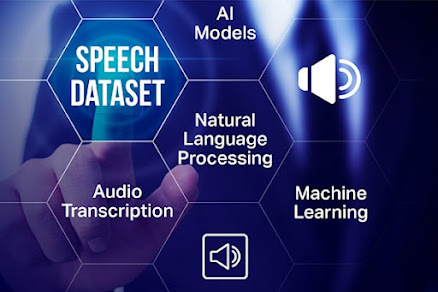WHAT ARE THE PROCESS OF CREATING SPEECH RECOGNITION FOR AI?
WHAT ARE THE PROCESS OF CREATING SPEECH RECOGNITION FOR AI?
In conjunction with the pandemic, AI advancements have prompted businesses to enhance virtual interactions with their customers. To improve their customer interactions, businesses are turning to chatbots, virtual assistants and other speech technology. Automatic Speech Recognition or ASR is the process that underpins these AI forms. ASR converts speech into text. This allows humans to talk to computers and understand them.
How Automatic Speech Recognition Works
has advanced significantly over the last decade thanks to machine learning algorithms and AI. Today's ASR programs are still based on directed dialogue. Advanced versions use the AI subdomain of natural-language processing (NLP).
Straight Dialogue Speech Recognition
You might have experienced directed conversation when you called your bank. Larger banks will often require you to communicate with a computer before speaking with someone. A computer might ask you to confirm your identity using simple statements (yes or no) or to read the card numbers. You're using directed dialogue ASR in either case. These ASR programs are limited in their ability to understand simple verbal responses, and therefore have a limited vocabulary. They are good for simple, brief customer interactions but not for complex conversations.
Natural Language Processing AI
NLP is an area of AI, as we have already mentioned. This is the method of teaching computers to understand human speech or natural language. This is a brief overview of how NLP-based speech recognition programs work.
- The ASR program can be asked a question or you can speak a command.
- The program converts your speech to a spectrogram. This is a machine-readable representation your audio file.
- Acoustic models remove background noises from your audio files, such as barking dogs or static.
- The algorithm analyses the phonemes of a sequence, and can use statistical probabilities to determine words and sentences.
- An NLP model will use context to determine whether you meant to say "write" and "right", respectively.
- Once the ASR software has understood what you are trying to communicate, it can respond to you using text-to-speech translation.
This overview will give you an idea of how these systems work. There are variations in the above process due to the different algorithms used. NLP-based ASR systems are the most advanced, as they have no limitations and can simulate real conversations. A typical NLP-based ASR system's lexicon could contain as many as 60,000 words. ASR is evaluated on its word error rate (or speed) and ability to understand human speech. However, in ideal circumstances, systems can attain close to 99% accuracy.
Data scientists continue to explore ways to teach ASR programs to understand human speech. They're looking for other ways to supplement fully supervised training, which involves teaching the AI every possible language and using techniques like active learning. The more people that interact with the program, it will learn more independently. Researchers will see a significant time savings as a result.
Speech Recognition Applications
Speech recognition applications offer a wide range of possibilities. Many industries have already adopted this technology to improve the customer experience. These are just a few of the outstanding applications.
- Voice-enabled Virtual Assistants These apps are becoming more common because of the ease and speed with which they can obtain information. It is expected that the virtual assistant market will continue to grow.
- Transcription and transcription: Many industries use speech transcription services. It can be used to transcribe company meetings, customer calls in sales, investigation interviews in government, or even capture medical notes for a patient.
- Education: ASR can be used for educational purposes. ASR can be used to teach second languages.
- Accessibility: ASR can also be a promising tool in advancing accessibility. People with difficulty using technology, for instance, can now speak to their phones and make calls. "Call Jane" is one example.
Many of the applications mentioned above can be used across industries. Therefore, it is not surprising that ASR technology's market has grown exponentially over the past few years.
How to Surmount the Challenges of Automatic Speech Recognition
We have already mentioned how ASR can be difficult in live environments, which impacts the accuracy rate of technology. ASR implementation can be complicated by common issues. There are ways to overcome these obstacles.
Noisy Data
While noisy data can be understood to refer only to meaningless data, ASR also uses it to its literal meaning. The ideal audio file would contain clear speech and no background noise. But this is often not the case. Audio data can pick out irrelevant noises like someone coughing, another person speaking in the background, construction noises or static. A good ASR system will be able to identify the important areas and eliminate the irrelevant.
Speaker Variabilities
ASR systems are often required to understand people of different backgrounds and genders. Here are some examples of how speech can differ from person to person.
- Language
- Dialect
- Accent
- Pitch
- Volume
- Speed
Poor Hardware
High-quality audio hardware is often not available to companies, leading to noisy data.
Manufacture of word boundaries is lacking
Our sentences and words have clear boundaries when we write or type: punctuation, spaces, and punctuation. But when we speak, words and sentences can often be mixed together. ASR programs may have difficulty separating the parts of speech that are different words.
OFFER GTS PROVIDES
Global Technology Solutions (GTS) provides you with all the data you could possibly need to power your technology in whatever dimension of speech, language, or voice function you would want. We have the means and expertise to handle any project relating to constructing a natural language corpus, truth data collection, semantic analysis, and transcription.

.png)


Comments
Post a Comment